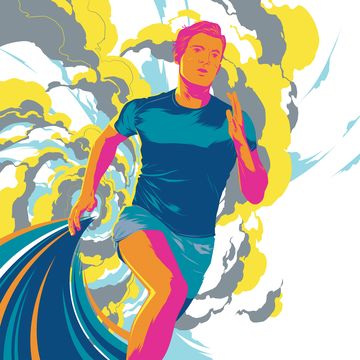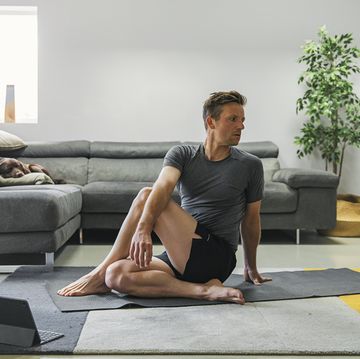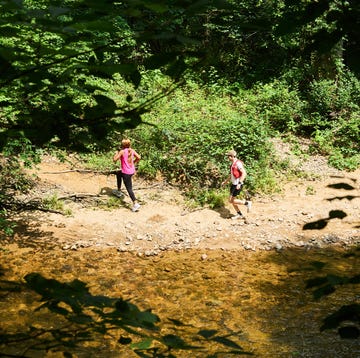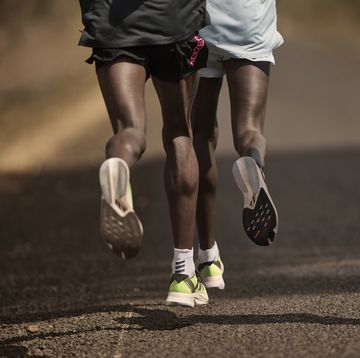Whether you've just started running or have been doing it for years, I have one question: do you do speed sessions at the track? I’m asking because, in my humble opinion, the running track rocks. I know many people find that oval intimidating (and to be honest, so did I at the start) and a place where only fast runners go. This is true – but then people like me and you go to the running track too.
If I started running again from scratch, I’d opt for the track as my place to train. Since most tracks are 400m around, at my TrackMafia sessions I’d always say you’re only ever 400m from the finish – so why not push your limits and experiment with your running there? If the wheels fall off, just reset, recover and go again.
The running track – in numbers
Let’s start with some simple track stats. As mentioned, most running tracks measure 400 metres from the inside lane – which is lane one of (usually) eight – and feature 100m-long straight sections, known as straightaways, where 100m races are held. It’s worth noting that the outside lane is around 40-50 metres longer than the inside lane, which is why some race starts are staggered to give all runners a fair shot.
Benefits of training on the running track
There are tons of advantages to running on the track – and they might inspire you to find your lane and get going.
It adds some fun to speedwork
Every Thursday night at the running track felt like a special occasion. My friends and I would meet in a coffee shop, walk over there together as part of a warm-up ritual and then get started with some easy laps, drills and strides. The rubber track surface felt springy, as if it was offering help and giving back some speed-inducing energy. It also felt more forgiving and a touch easier on both my muscles and joints than harder running surfaces like pavements, which encouraged me to push that little bit harder.
It helps you find your running pace
On a running track, you don’t have to watch out for traffic or road crossings, or navigate uneven, undulating terrain – you’re in a safe environment where you can simply focus on the run. This, partnered with the fixed lap distance of a running track, lets you hone consistency, which is key to helping you develop as a runner. This gets your body accustomed to running at particular paces, so when it comes to race day you can slip into autopilot and put all your training into action.
It’s great for group sessions
During sessions at the running track, we’d all take turns leading the rep, occasionally battling a headwind along the way. Although you’d want to ease off at times, you knew that this rep wasn’t just yours – it was the team’s rep. Accountability and team spirit like that can help you to keep going for longer and push harder than you might do if you were running alone.
How to start training on the running track
Trying anything new is always daunting. So, on your first visit to the running track, why not just do your normal run? Or you could perhaps do a normal run that starts and finishes on the track? No speed work to start – just a nice, easy run. Check it out and see what it feels like to run around that oval. Then, as you get more comfortable and find your running feet, you can start to introduce some speedier track sessions.
Running track etiquette
As with any run – whether that’s ticking off some easy miles on the trails or a tempo session on the roads – you’ll want to top and tail your track session with a 15-minute jog at an easy pace. At the end of your warm-up jog, complete some strides to help elevate your heart rate and prime your muscles for the speed work ahead.
But, unlike runs beyond the oval, runs around the track involves some unwritten rules that you’d do well to follow. The track is open to all, so here are a few tips to help you – and others – have the best experience there:
- Run anticlockwise if you’re running along the inside lanes.
- If you’re about to pass other runners but not going full pelt, let them know your intention with an ‘On your right!’ and pass them on this side. If you’re on a hot lap and really need that inside lane, say ‘On your left!’ and take this course when the space is free.
- Be graceful and compliant if other runners want to pass you – they just want to get by.
- Don’t walk in lane one when the track is active.
- Likewise, don’t stop abruptly on the track – instead, look both ways, then peel off when it’s safe.
- Runners often want to give 100% when they’re running on a track, so it’s good to be aware of what’s going on around you – as such, it’s best to leave your headphones at home.
Running track workouts
Running on the track helps your body to become familiar with managing discomfort, which means your comfortable pace will gradually get faster over time. When you first do these workouts, feel free to take breaks between each rep. Then, you can build up to doing these workouts continuously.
200m repeats
- 50m easy, 150m hard
- Complete 7-10 reps
400m repeats
- 200m easy, 150m hard, 50m all-out effort
- Complete 5-7 reps
600m repeats
- 200m easy, 400m hard
- Complete 4-6 reps
800m repeats
- 50m easy, 150m hard
- Complete 3-5 reps
Cory Wharton-Malcolm is a running coach, RW columnist and founder of TrackMafia. You can follow him on Instagram here: @bitbeefy and @trackmafia_













